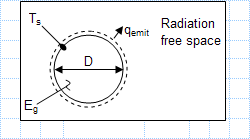Emissivity of spherical interplanetary probe.xls

Description
Known: Diameter and emissivity of spherical interplanetary probe. Power dissipation within probe.
Find: robe surface temperature
Assumptions:
1) Steady-state conditions
2) Negligible radiation incident on the probe
Analysis:
Conservation of energy dictates a balance between energy generation within the probe and radiation emission from the probe surface.
Calculation Reference
Fundamentals of Heat and Mass Transfer - Frank P. Incropera
To find the surface temperature of a spherical interplanetary probe, considering the diameter, emissivity, and power dissipation within the probe, you can follow these steps:
-
Calculate the surface area: The surface area of a sphere can be calculated using the formula:
Surface Area = 4πr^2
Where r is the radius of the sphere. Since the diameter (D) is known, you can calculate the radius (r) as r = D/2.
-
Calculate the power radiated by the probe: The power radiated by the probe can be calculated using the Stefan-Boltzmann Law:
Power Radiated = ε * σ * Surface Area * T^4
Where ε is the emissivity of the probe, σ is the Stefan-Boltzmann constant (approximately 5.67 x 10^-8 W/(m^2·K^4)), Surface Area is the surface area of the probe, and T is the surface temperature of the probe.
-
Set up the energy balance equation: For steady-state conditions, the power dissipated within the probe must equal the power radiated by the probe:
Power Dissipated = Power Radiated
Substitute the known power dissipation within the probe into the equation.
-
Solve for the surface temperature: Rearrange the energy balance equation to solve for the surface temperature (T):
T = ((Power Dissipated) / (ε * σ * Surface Area))^0.25
Substitute the known values of power dissipation, emissivity, Stefan-Boltzmann constant, and surface area into the equation and solve for the surface temperature.
By following these steps and applying the principle of energy conservation, you can determine the surface temperature of the spherical interplanetary probe, considering its diameter, emissivity, and power dissipation. This calculation accounts for the balance between energy generation within the probe and radiation emission from its surface.
Calculation Preview
Full download access to any calculation is available to users with a paid or awarded subscription (XLC Pro).
Subscriptions are free to contributors to the site, alternatively they can be purchased.
Click here for information on subscriptions.

